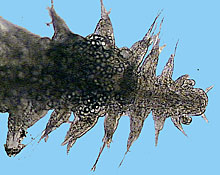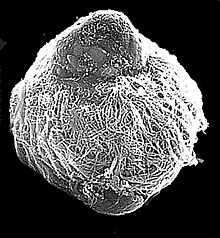
The larva of an unidentified polychaete worm collected from the plankton directly over a cold seep on the Louisiana slope. This worm larva may be from a seep animal on the bottom, but it may also be from a worm living in the sediment far away from any cold seeps. Click image for a larger view.
The Wayward Children of Worms
Craig M. Young
Oregon Institute of Marine Biology
![]() View a video of tubeworm sperm being released in actively swimming bundles. (mp4, 449 kb)
View a video of tubeworm sperm being released in actively swimming bundles. (mp4, 449 kb)
Tubeworms living at cold seeps and hydrothermal vents are completely dependent on hydrogen sulfide, which provides energy for their growth, metabolism and reproduction. However, sulfide is not abundant everywhere in the marine environment. Because suitable habitats for these worms are found only in places with certain geological features, scientists have long wondered how tubeworms survive when their habitats change, and how the animals locate and colonize new habitats.

Ciliated larva of a tubeworm from the Gulf of Mexico, reared in the laboratory. At this stage, there is a very broad band of moving cilia that cause the larvae to spin and propel it forward. The bump on top is the posterior end of the worm, which has started to elongate. This photograph was taken with a scanning electron microscope. Click image for larger view.

Sperm of tubeworms are released in actively swimming bundles that eventually break apart into individual sperm. The sperm heads are unusual, having a helical nucleus (containing the DNA) wrapped around a helical mitochondrion (the structure that fuels swimming). (QuickTime, 556 kb) Click image to view video.
Only recently have scientists been able to rear the embryos and larvae of seep tubeworms in the laboratory. Eggs and sperm removed from adults are mixed together in glass bowls to produce embryos, which are kept in incubators. Embryos and larvae of the seep tubeworm Lamellibranchia will live in glass dishes as long as the dishes are held at the same cold temperatures found on the sea floor.
The eggs and embryos are filled with a fatty yolk that is lighter than seawater, allowing them to float upward for more than a week before sprouting tiny cilia that propel them back down toward the bottom. The larvae do not feed while drifting. So they must find a new habitat before consuming all of the nutritious yolk in the eggs, a time span of about three weeks. In the typical deep currents found on the Louisiana Slope, larvae probably can drift as much as 60 km during their three-week dispersal period. Although we do not know how many larvae successfully find a new seep habitat, it seems likely that the majority are either eaten by predators or run out of energy before they find a suitable habitat. However, female tubeworms can produce eggs continuously and may live for as long as 200 years. So their chances of producing at least some successful offspring are probably good.
Because larvae are microscopic and difficult to study, many questions remain. For instance, how do the larvae of vent animals identify appropriate sites for attachment? Can they "smell" sulfide or methane? Do they respond to the odors of adults? How, when and where do they obtain their symbiotic bacteria? Do they have a mouth in any stage of their development? What animals eat the larvae? How much of the energy in seep eggs makes its way into the planktonic food web?
Sign up for the Ocean Explorer E-mail Update List.























